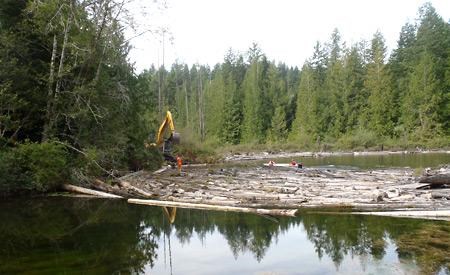Log debris in Haslam Lake adjacent to the weir has been removed. The project was a joint effort between the City of Powell River and Powell River Regional District.
Councillor Jim Palm, who is also a city director on the regional board, reported at the August 29 council meeting that the logs had all been removed in three days last week. They were chipped up and transported to Catalyst Paper Corporation’s Powell River mill, where they will be used for fuel.
Jeremy Sagebiel, an engineering technologist with the city, said every effort was taken to ensure there was no damage to the lake environment and habitat. “All floating wood debris was removed and the debris that was beached or embedded in the lake floor was left because of the potential damage to the environment,” he said. Bob Marquis Contracting Ltd. was awarded the contract to remove the logs and an environmental consultant was on site.
The city allocated $25,000 in its 2013 budget for the project. The regional board approved spending $40,000 for the project in June. The funds came from the community works fund reserve and Colin Palmer, board chair and Electoral Area C director, initiated the motion.
The Haslam Lake-Lang Creek watershed is entirely within Electoral Areas B and C of the regional district. The city has a licence to withdraw water from the lake to use for drinking water, but it must also ensure that a certain amount of water spills into Lang Creek to provide adequate water downstream to support salmon habitat. As well, Lang Creek is a source of drinking water for some rural residents.
In 2005 some logs from the buildup almost pushed through the weir. The Powell River Salmon Society thought that if the water level had been higher at the time, the whole weir would have collapsed.
In 2012, Palmer, Palm and Tla’amin (Sliammon) First Nation representative Craig Galligos co-chaired a Haslam Lake Watershed Roundtable meeting. It was noted at that meeting that there was a need for plans to avoid, or manage, a buildup of debris at the weir.
Palmer pointed out the Haslam Lake and Lang Creek Integrated Watershed Management Plan was adopted in 1999, and it took six years of work to create the document. “It took three days to get the logs out and it took 20 years to do it,” he said.
The document noted the buildup of logs at the weir was a problem, Palmer said. Now that the logs are gone, there is less of a threat to the weir. “It protects the whole river downstream, the salmon society and the Brew Bay Improvement District,” he said. “It also means that hopefully, the city will now have a program to keep that area clear on a regular basis.”
The roundtable has identified three more projects that need to be done in the watershed, Palmer said, and currently quotations are being collected for the work. “Once we’ve got them, we’ll send them around to the roundtable to see whether they want us to go ahead with them,” he said.
One of the projects is to update the plan. “It’s not to rewrite the intent of it all, but the stakeholders have changed and a lot of the ministries and departments aren’t even there anymore,” Palmer said.
For instance, one of the major stakeholders is the Powell River Community Forest. As well, Tla’amin has a community forest in the watershed. “There are significant changes in that respect,” Palmer said. “What we wanted to do was correct the changes rather than rewrite the intent of the plan.”
Other projects include dealing with some sedimentation issues and constructing a bridge on one of the streams leading into Lang Creek.
Community works funds flow from an agreement to transfer federal gas tax revenues. Eligible project categories include public transit, community energy systems, water and wastewater, solid waste management and capacity building. Directors have been debating how to use the funds allocated to the regional district, an amount estimated to be $225,000 as of the middle of August.
Regional district elected officials have directed staff to prepare a draft policy to state that community works funding received in favour of electoral areas be reserved for disposal at the discretion of electoral area directors. The draft policy is expected to be tabled in the near future.



